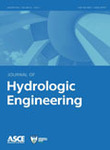Journal


Journal of Hydrologic Engineering
Archives Papers: 314
The American Society of Civil Engineers
Please choose volume & issue:
-
Analyzing Groundwater Recharge and Vadose Zone Dynamics by Combining Soil Moisture and Groundwater Level Data with a Numerical Model in Subarctic Conditions
Abstracts:Quantitative estimates on the magnitude and dynamics of vadose and groundwater zones in subarctic conditions are rare. Furthermore, knowledge on the constraints of different data on numerical groundwater recharge estimates (i.e., data worth analyses) is limited. We built a process-based three-dimensional hydrological model to describe and analyze the dynamics and magnitude of groundwater recharge, vadose zone, and related key hydrological components in subarctic conditions. Three-year time series of daily groundwater level and soil moisture (five different depths) data were used to identify plausible model realizations. Thereafter, long-term simulations over 6 years were conducted. The model adequately corresponded with the magnitude and dynamics of the observations, even though the simulations and observations occasionally differed. Simulations with several different plausible parameterizations showed how soil moisture and groundwater level fluctuations, as well as recharge estimates, are sensitive to water retention parameter variations, whereas precipitation and evapotranspiration controlled the recharge magnitude. Recharge showed clear interannual variability (annual mean 0.28–0.60 m). The fraction of annual mean recharge over precipitation was 39%–66% during our simulation period. We showed how groundwater level data can set more constraints on the recharge estimates than soil moisture data, and how both of the data types together constrained the recharge estimates the most. We showed how the vadose zone had modest dynamics and storage properties (typically 2%–8% of the total soil water) in terms of the bulk soil water storage. However, the average amount of the air-filled pore space (0.70 m) and water (0.38 m) in the vadose zone were proportional to annual precipitation and evapotranspiration, respectively. Thus, the vadose zone can form an important boundary between the soil surface and groundwater zone, and its role is not highly sensitive to hydrometeorological fluctuations. Data worth analyses provide a potential opportunity to move toward increasingly reliable model-based groundwater recharge estimates and system understanding.
-
Spatial-Temporal Variations of Extreme Precipitation Indices in the Xinjiang Cold Area over the Past 60 Years
Abstracts:The damage of extreme precipitation to the social economy and ecological environment has attracted extensive attention. Daily precipitation data of 59 meteorological stations located in Xinjiang Uygur Autonomous Region were selected, where the temporal and spatial distribution and variation characteristics of extreme precipitation from 1961 to 2017 were comprehensively analyzed by percentile threshold method, precipitation tendency rate method, the trend-free pre-whitening Mann Kendall trend test, Mann Kendall mutation test, and other methods. Further, three methods, the continuous wavelet transform, cross wavelet transform, and wavelet coherence analysis, were selected to analyze the correlation between extreme precipitation index and six atmospheric circulation indexes. Results show that from 1961 to 2017, the precipitation in Xinjiang increased, and the extreme precipitation (R99P), extreme precipitation days (R99D), extreme precipitation contribution rate (R99C), and extreme precipitation intensity (R99I) showed a significantly increasing trend. Due to the influence of topography, the spatial distribution of extreme precipitation is bounded by the Tianshan Mountains, decreasing from northwest to southeast, meeting the characteristics of “Northern Xinjiang is greater than Southern Xinjiang,” indicating obvious spatial heterogeneity. Among the selected atmospheric circulation indexes, Western Pacific Subtropical High Intensity Index (WPSHII) and Western Pacific Subtropical High Intensity Index (SCSSHII) contribute significantly to extreme precipitation events in Xinjiang. There is an obvious positive correlation between SCSSHII and extreme precipitation index. In other words, the greater the SCSSHII, the greater the frequency and frequency of extreme precipitation events in the study area, and the more prone it is to natural disasters such as rainstorms and floods.
-
Identification and Quantification of Surface Depressions on Grassy Land Surfaces of Different Topographic Attributes Using High-Resolution Terrestrial Laser Scanning Point Cloud and Triangulated Irregular Network
Abstracts:The objective of this study was to identify and quantify surface depressions on grass-covered land surfaces using a high-resolution terrestrial laser scanning (TLS) point cloud, and a triangulated irregular network (TIN). The entire grassy land surface in the study area was divided into five subwatersheds of different topographic attributes (i.e., depression depth and surface slope). Surface depressions were identified and quantified using a TIN generated from a high-resolution TLS point cloud. The results indicated that microtopography of the grassy land surface was well-characterized within each subwatershed in comparison with field observations. With the terrestrial light detection and ranging (LIDAR) point cloud of 15-mm point spacing and the TIN method, surface depression storage depths of the five subwatersheds ranged from 1.73 to 14.28 mm in the study area. The surface depression storage depth, as expected, increased with the maximum depth of surface depression. It was also found to increase when the land surface slope became milder. A sensitivity analysis indicated that a point cloud with a point spacing of 30 mm was sufficient to obtain an accurate representation of the terrain surface in the study area. This study also indicated the TIN method can represent the ground surface and the surface depression more realistically than the commonly used digital elevation model (DEM) method due to the TIN method’s higher capability of identifying and filtering out surface obstructions such as blades of grass. Moreover, by using the high-resolution TLS technology and the TIN method, our study provides an important and broad range of reference data on the surface depression storage depth commonly needed in application of the Storm Water Management Model (SWMM) and other watershed models.
-
Inferences of Groundwater Response to Projected Hydroclimatic Changes in North Florida
Abstracts:Discerning anthropogenic stressors on groundwater is critical for climate change adaptation to reduce risks and increase resiliency. Long-term groundwater level trends are forecasted and examined at three sites in North Florida using a large ensemble of Global Climate Model (GCM) projections under low and medium emission scenarios. The forecasts indicate groundwater levels are likely to decline from 2020 to 2099. However, the declines are expected to accelerate after 2040s, reaching critical levels by the end of this century. Pumping impact constitutes 10% to 45% of future declines but is amplified by enhanced drought. Examination of distinct influence of rainfall, evapotranspiration (ET), and groundwater pumping on future trends shows highly divergent groundwater response to projected hydroclimatic changes. The future long-term rainfall trend may lead to rising groundwater levels, which may be overshadowed by heightened ET loss driven by climate change and increased groundwater pumping, causing steep declines. This study also reveals poor performance of predictions driven by GCM projections in replicating the timing of high and low levels at the sites influenced by Florida’s peninsular climate due to the limitation of downscaling and bias-correction to capture oscillations in climate cycles driving hydrologic memory. However, groundwater levels are predicted well by a few GCMs at one site influenced primarily by continental climate. Additionally, a multidecadal harmonic analysis exposes presence of centennial periodicity in groundwater levels, which opens a new perspective in the understanding of climate change impacts on groundwater resources. Further investigation is needed to better understand the effect of centennial cycles on future groundwater levels and how these cycles can be incorporated into the downscaling methods. Hence, GCM-based forecasts are recommended to be cautiously utilized for groundwater resource planning when they significantly depart from historical long-term cyclic patterns.
Hot Journals
- Risk Breakdown Matrix for Risk-Based Inspection of Transportation Infrastructure Projects
- Social Control in Outsourced Architectural and Engineering Design Consulting Projects: Behavioral Consequences and Motivational Mechanism
- 2022 Best Paper Award
- Hold-Ups and Failures in Negotiated Order: Unearthing the Nuances of Rework Causation in Construction
- Prevalence and Risk Factors for Poor Mental Health and Suicidal Ideation in the Nigerian Construction Industry
- CFRP–Cable-Stayed Bridge Hybrid with Partial Suspension and a Span Exceeding 3,000 m: Concept, Optimization, and Construction
- Impact of Wind Load Characteristics on Computed Bridge Stay-Cable Forces Used for Bridge Health Monitoring
- Weak-End and Frequency Detection of Elastically Supported Bridges by Contact Residual Response of Two-Axle Test Vehicle in a Round Trip
- Development of Performance-Based Fragility Curves of Coastal Bridges Subjected to Extreme Wave-Induced Loads
- An Analytical Model to Evaluate Short- and Long-Term Performances of Post-Tensioned Concrete Box-Girder Bridges Rehabilitated by an Ultrahigh-Performance Concrete Overlay
- Three-Dimensional Velocity Distribution in Straight Smooth Channels Modeled by Modified Log-Law
- Experimental Investigation on Flow Past Two and Three Side-by-Side Inclined Cylinders
- An Experimental Investigation of Rotor–Box Aerodynamic Interaction 1
- Modeling Gas–Liquid Flow Between Rotating and Nonrotating Annular Disks
- Entry Length Requirements for Two- and Three-Dimensional Laminar Couette–Poiseuille Flows
Advanced Materials (3,745)
- Structured Perovskite Light Absorbers for Efficient and Stable Photovoltaics
- Strategies for High‐Performance Solid‐State Triplet–Triplet‐Annihilation‐Based Photon Upconversion
- Atomic Engineering Catalyzed MnO2 Electrolysis Kinetics for a Hybrid Aqueous Battery with High Power and Energy Density
- Crystal Adaptronics: Global Performance Indices for Dynamic Crystals as Organic Thermal Actuators (Adv. Mater. 20/2020)
- Enlightening Materials with Photoswitches
Acta Astronautica (1,768)
- Mixed-integer trajectory optimization with no-fly zone constraints for a hypersonic vehicle
- Adaptive control design for active Pogo suppression of large strap-on liquid launch vehicles
- Machine learning based approach for modeling and forecasting of GPS–TEC during diverse solar phase periods
- Effect of two-dimensional micro-cavity surface on hypersonic boundary layer
- Investigation on burning behaviors of aluminum agglomerates in solid rocket motor with detailed combustion model








 User Center
User Center My Training Class
My Training Class Feedback
Feedback




